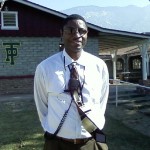
Photo by Marshall Smith
After suffering a debilitating stroke in 2014, retired registered nurse Dorothy Brooks had to choose. Unable to walk and severely challenged with balance issues, visual distortions, memory loss and speech impairment, Brooks decided she had to find her own way out of her disabilities.
She chose adult coloring books. “I went home to color,” she recalled, “and my brain began to rewire.”
Citing Dr. Rich Hanson’s research in “Hardwiring Happiness: How to Reshape Your Brain and Your Life” (Crown Publishing, 2013), Brooks used her positive experiences with and reactions to coloring to gradually transform her neural structures — healing them with contentment, love and mindfulness. After three months, she began to notice significant improvement. “The brain reacts to positive stimuli,” said Brooks. Hanson’s work stresses the healing properties of mindful presence, the power of intention and experiencing empathy.
As soon as she could, Brooks began to volunteer in Thermal, mentoring children in a “Read With Me” program that acted to improve her own visual acuity and cognitive ability. And it was not just the specific requirements of the reading program that helped her, it was the experience of volunteering, of giving to others, that sent positive and loving messages to the brain — creating healing.
In Idyllwild, continuing her recovery while still using her cane, Brooks began using the Fit After 50 exercise regimen, developed at Cal State Fullerton. It is an evidence-based exercise program with emphasis on preventing falls, and improving core strength, balance and mobility. Eventually Brooks took over the Idyllwild program. She encouraged her students, many recovering from injuries with balance and mobility issues, that exercise can heal, when done mindfully. “I’d say, ‘I had this injury,’ you can do this, too,” Brooks related. “You can heal yourself from an injury and you can heal conditions before you get sick,” said Brooks. “Pay attention to your body. It will tell you.”
Brooks, who had a stressful career as a nurse, both in working with law enforcement and later as an organ-transplant coordinator, cited the importance of finding balance in one’s life. “Kindness — that’s what I’m practicing now,” she said. “I just feel whole now. I’m a happy person.”
And as evidence of that balance and happiness, Brooks in her interview, was positive, enthusiastic and vibrantly youthful.
Brooks offers the free Fit After 50 program, sponsored by the Riverside County Office on Aging, at St. Hugh’s Episcopal Church on Tuesdays from 1:30 to 2:30 p.m. in the meeting room adjoining the sanctuary. Thursday sessions are added in the winter.
Brooks believes that exercise and a healthy diet, supplemented with sufficient daily water intake, lead to happiness and a deeper sense of well being. She cites the benefits of exercise, as noted in the Fit After 50 brochure, as increased muscle strength, endurance and bone density, increased balance and flexibility, decreased blood pressure, reduced body fat, reduced tension, anxiety and fatigue, reduced pain, improved sleep, and the camaraderie of shared beneficial activity.
For more information about the program, and to experience Brooks’ uplifting class and coaching, call 951-659-2587.










